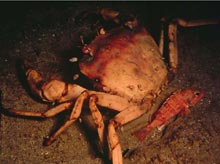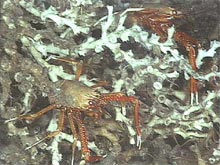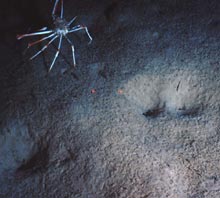
This golden crab (Chaceon fenneri) is the size of a dinner plate. A blackbelly rosefish (Helicolenus dactylopterus) floats in its wake. Photo courtesy Betty Wenner, SCDNR. Click image for larger view.
Giant Crabs
(and Their Smaller Cousins)
of the Charleston Bump
August 2, 2003
Dr. Elizabeth L. Wenner
Research Marine Scientist
Marine Resources Center
South Carolina Department of Natural Resources
“I should have been a pair of ragged claws/Scuttling across the floors of silent seas.”
- T.S. Eliot, from The Love Song of J. Alfred Prufrock
Perhaps the most conspicuous mobile organisms encountered on our dives are crabs. Often seen lumbering along the bottom or poised on a rocky ledge, the larger crabs are quite colorful, ranging from bright orange to red- and-white mottling on their shells and legs. Although largely ignoring the submersible until approached, some will assume a fighting stance with arms outstretched toward the source of disturbance in their normally dark world.
The large, dinner-plate-sized crabs can leave tracks as they move across soft sediments where little or no currents stir up the bottom. For the most part, it is hard to find any telltale crab tracks on the Charleston Bump due to the swift currents that scour the bottom and smooth out the sediment veneer, just as a strong wind can obscure footprints after a snowstorm.

These deep-water crabs (Eumunida picta Longispina) are commonly seen on the mounds of Lophelia, a deep-dwelling coral. Photo courtesy Betty Wenner, SCDNR. Click image for larger view.
The golden crab (Chaceon fenneri) is the most commonly encountered of the lumbering giants. Prized for its meat, this crab occurs along the U.S. coast, in waters off Bermuda, throughout the Bump area, and into the Gulf of Mexico. Golden crabs occur in a variety of habitats along the continental slope but are most abundant among rock ledges, where they consume benthic (bottom-dwelling) organisms such as worms and mollusks.
A relative of the golden crab, the jonah crab (Cancer borealis) occurs along the entire East Coast, from Nova Scotia to the Tortugas at the southernmost tip of the Florida Keys. It appears to undergo tropical submergence, occurring in deeper waters off the southeastern U.S. coast than off New England. Jonah crabs off South Carolina are most abundant on the soft ooze found on the upper continental slope, and are infrequently seen on the coral mounds near the Charleston Bump. The crab's preference for soft-bottom habitats no doubt relates to its burrowing lifestyle. Jonah crabs dig vertical burrows or pits in order to expose prey. During past dives on the continental slope, we have seen one of the largest predators of the deep, the six-gilled shark, select jonah crabs as a dinner item.
Some of the more colorful inhabitants frequently seen on the coral mounds include a deep-water relative of the common estuarine blue crab. This colorful swimming crab (Bathynectes longispina) occurs throughout the western Atlantic. They are sometimes seen in association with the galatheid crab (Eumunida picta,) crawling among the coral branches and fan-shaped sponges, crinoids, and other sessile (stationary) organisms that cover deep-sea coral mounds. The red coloration of both these crabs is quite striking among the creamy white coral -- and under the harsh lights of a submersible. Their red coloration has a concealing effect, however, because the red rays from the sun are quickly absorbed in the upper depths, with the result that any crab moving at deeper depths would appear black in the dark waters of the Bump.

The inflated spiny crab (Rochinia crassa) in its preferred habitat, the soft-bottom ooze. Photo courtesy Betty Wenner, SCDNR. Click image for larger view.
Another colorful crab that we observed is the inflated spiny crab (Rochinia crassa), which resembles a large spider. This species primarily occurs over soft ooze and is not common on the coral mounds or the rocky ledge habitats. It feeds on bottom-dwelling organisms including polychaete worms and mollusks. Its long, spider-like legs are a clue that it is a relative of the commonly seen spider crabs that occur in shallow coastal areas along the U.S. East Coast. When disturbed, this crab attempts to move away from the sub with its legs all akimbo, reminiscent of some deep-water Ichabod Crane!
Not all of the crabs are large. Some make their homes within the bottom sediments, under ledges, and even within sponges and among the corals. These more cryptic inhabitants are not as visible as their large relatives, but they are nonetheless fascinating, having their own particular adaptations to the deep-water habitat where they reside. But that’s a story for another day!
























